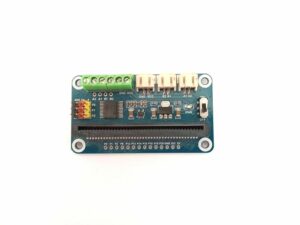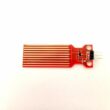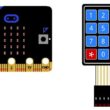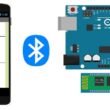GPIO expansion cards for Micro:bit

Definition of GPIO expansion cards for Micro:bit
GPIO (General Purpose Input/Output) expansion cards for Micro:bit are electronic boards that allow you to expand the input/output capabilities of the Micro:bit, a popular programmable microcontroller board used in education and DIY projects.
These expansion cards typically provide additional GPIO pins that can be used to connect various electronic components, such as sensors, motors, LEDs, buttons, and more. Some expansion cards also offer advanced features such as wireless communication, analog-to-digital conversion, and motor control.
GPIO expansion cards for Micro:bit come in different shapes and sizes, and are designed to be compatible with the standard Micro:bit edge connector. Some popular types of GPIO expansion cards for Micro:bit include the Type T GPIO expansion board, the Grove I2C connector board, the Servo driver expansion board, and the Motor driver expansion board.
These expansion cards are useful for a wide range of applications, including robotics, automation, home automation, and IoT (Internet of Things) projects. They allow you to easily interface with electronic components, and simplify the process of building complex circuits and systems with the Micro:bit.
Types of GPIO expansion board for Micro:bit
There are several types of GPIO (General Purpose Input/Output) expansion boards available for the Micro:bit, each with different features and capabilities. Here are some popular types:
Type T GPIO Expansion Board: This is a simple and inexpensive GPIO expansion board that provides 3-pin female headers for connecting sensors and actuators. It also includes a power switch and a status LED.
Grove I2C Connector Board: This board allows you to connect various Grove modules, which are pre-built sensors, actuators, and other components that can be easily integrated with the Micro:bit. The board has four Grove connectors and an I2C interface for communication.
Servo Driver Expansion Board: This board provides 16 channels of servo control, each with 12-bit resolution. It communicates with the Micro:bit via I2C and can be used to control multiple servo motors in robotics projects.
Motor Driver Expansion Board: This board allows you to control two DC motors or one stepper motor with the Micro:bit. It has two H-bridge drivers and an I2C interface for communication.
4tronix Bit:Bot Board: This is a comprehensive expansion board designed specifically for robotics projects with the Micro:bit. It includes a motor driver, a buzzer, an array of LEDs, and various sensors, as well as expansion headers for additional sensors and actuators.
These are just a few examples of the many GPIO expansion boards available for the Micro:bit. Each board has its own set of features and capabilities, and the choice of board depends on the specific needs of your project.
Examples of GPIO expansion cards for Micro:bit
There are many GPIO (General Purpose Input/Output) expansion cards available for the Micro:bit. Here are some examples:
Type T GPIO Expansion Board for Microbit

The Type T GPIO (General Purpose Input/Output) Expansion Board for Micro:bit is a simple and affordable expansion board that provides additional 3-pin female headers for connecting sensors and actuators. It is designed to be compatible with the standard edge connector on the Micro:bit, allowing you to easily expand its capabilities without soldering.
The Type T board provides 8 additional GPIO pins, which can be used to connect various electronic components, such as sensors, LEDs, motors, and more. The pins are labeled and color-coded to make it easy to identify their function.
The board also includes a power switch and a status LED, which can be used to indicate the state of your project. The power switch allows you to turn off the power to your project, which can be useful for saving battery life or preventing accidental activation. The status LED can be used to provide visual feedback, such as indicating when your program is running or when a sensor is triggered.
The Type T board is a useful expansion board for beginners and hobbyists who want to experiment with electronic projects and learn how to use the GPIO pins on the Micro:bit. It is also compatible with many other expansion boards and sensors, allowing you to build more complex projects as you gain experience.
Expansion driver board for Micro:bit

An expansion driver board for the Micro:bit is an add-on board that provides additional capabilities to the Micro:bit, such as motor control, sensor interfaces, and more. These boards typically connect to the Micro:bit's edge connector and provide additional pins and interfaces for connecting various components.
Some common types of expansion driver boards for the Micro:bit include:
Motor driver boards: These boards provide one or more H-bridge circuits for controlling DC motors or stepper motors. They typically connect to the Micro:bit's edge connector and provide additional screw terminals or connectors for connecting motors and power.
Servo driver boards: These boards provide one or more channels for controlling servo motors, which are used in many robotics applications. They typically connect to the Micro:bit's I2C bus and provide additional connectors for connecting servos.
Sensor interface boards: These boards provide additional connectors and interfaces for connecting various sensors, such as temperature sensors, light sensors, and more. They typically connect to the Micro:bit's edge connector and provide screw terminals or headers for connecting sensors.
LED driver boards: These boards provide additional outputs for controlling LEDs, such as NeoPixels or other addressable LEDs. They typically connect to the Micro:bit's edge connector and provide additional connectors for connecting LED strips or arrays.
Micro:bit GPIO Expansion Board

The Micro:bit GPIO (General Purpose Input/Output) Expansion Board is an add-on board that provides additional GPIO pins for the Micro:bit. It typically connects to the Micro:bit's edge connector and provides additional pins and interfaces for connecting various electronic components.
The GPIO Expansion Board is designed to be compatible with the standard edge connector on the Micro:bit, allowing you to easily expand its capabilities without soldering. It typically provides 17 additional GPIO pins, which can be used to connect various electronic components, such as sensors, LEDs, motors, and more.
The GPIO Expansion Board also includes a power switch and a status LED, which can be used to indicate the state of your project. The power switch allows you to turn off the power to your project, which can be useful for saving battery life or preventing accidental activation. The status LED can be used to provide visual feedback, such as indicating when your program is running or when a sensor is triggered.
The GPIO Expansion Board is a useful expansion board for beginners and hobbyists who want to experiment with electronic projects and learn how to use the GPIO pins on the Micro:bit. It is also compatible with many other expansion boards and sensors, allowing you to build more complex projects as you gain experience.
16-Channel, 12-Bit, I2C Servo Driver Board For Micro:bit

The 16-Channel, 12-Bit, I2C Servo Driver Board is an expansion board for the Micro:bit that allows you to control up to 16 servos with 12-bit precision. It communicates with the Micro:bit over the I2C bus, which makes it easy to connect and control multiple servos without using up all of the Micro:bit's GPIO pins.
The Servo Driver Board typically provides 16 servo connectors and a power input for supplying power to the servos. It also includes an onboard voltage regulator to ensure that the servos receive a stable and reliable power supply.
The board can be controlled using Micro:bit programming languages such as MicroPython or JavaScript, and there are many libraries and examples available to help you get started with controlling your servos. You can program the board to control the position, speed, and direction of the servos, which makes it ideal for robotics projects and other applications that require precise control over servo motors.
The Servo Driver Board is a useful expansion board for hobbyists and makers who want to build more complex projects with the Micro:bit. It allows you to easily control multiple servos with high precision, which can be useful for building robots, animatronics, and other projects that require precise servo control.
The role of GPIO expansion cards for Micro:bit in robotics
GPIO expansion cards for Micro:bit play an important role in robotics projects. They allow you to add additional inputs and outputs to the Micro:bit, which can be used to control various electronic components such as motors, sensors, and other peripherals. This makes them ideal for building robots and other projects that require precise control over various components.
In robotics projects, GPIO expansion cards for Micro:bit can be used to control the movement of robots using motors and servos. For example, you can use an expansion board with motor drivers to control the direction and speed of DC motors or stepper motors. You can also use an expansion board with a servo driver to control the position and movement of servo motors.
GPIO expansion cards can also be used to read data from sensors such as ultrasonic sensors, infrared sensors, or light sensors. This data can be used to control the movement of the robot, such as detecting obstacles and adjusting the direction or speed of the motors accordingly.
In addition, GPIO expansion cards for Micro:bit can be used to add communication interfaces to your robot, such as Bluetooth or WiFi, which can be used to control the robot remotely or to transmit data from the robot to other devices.
























